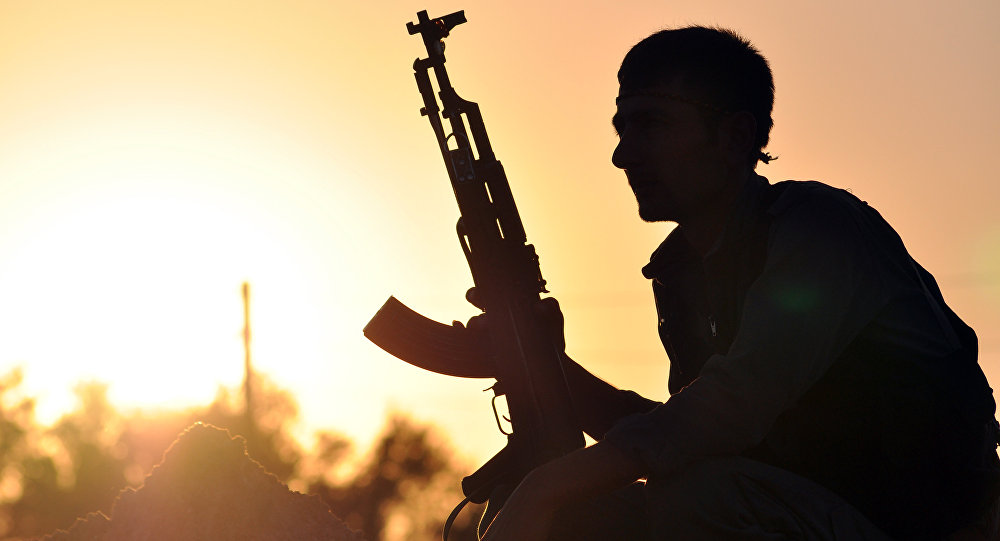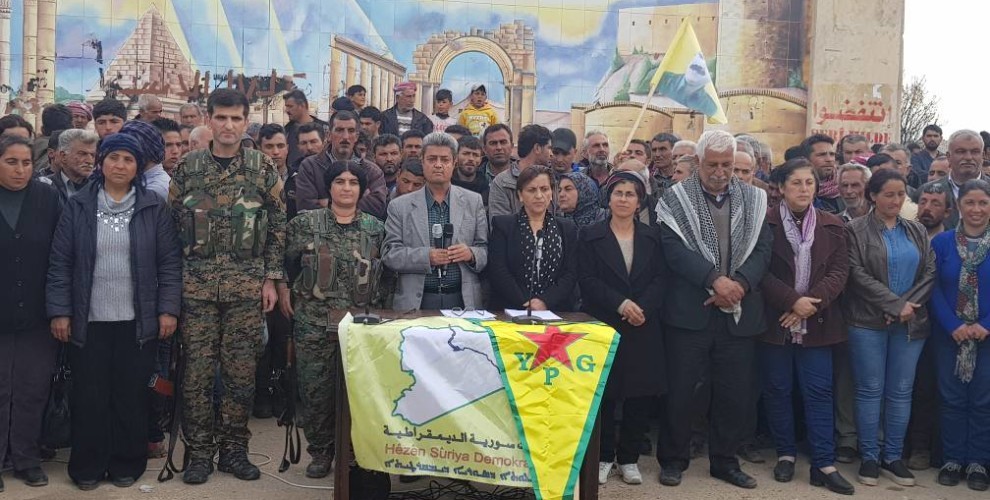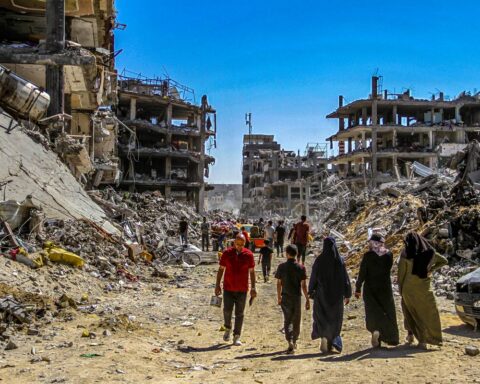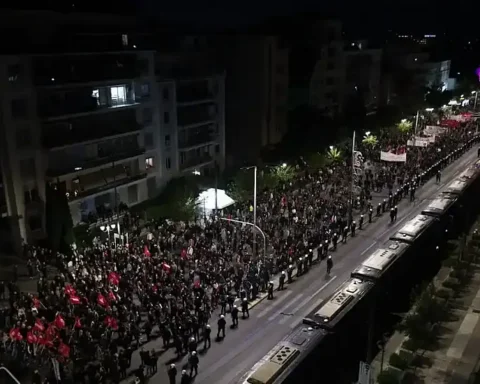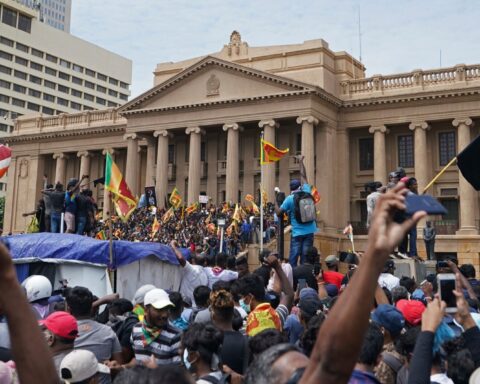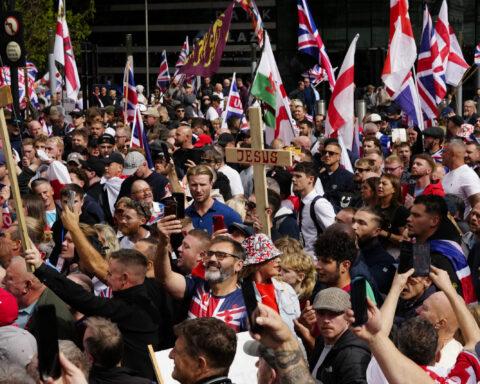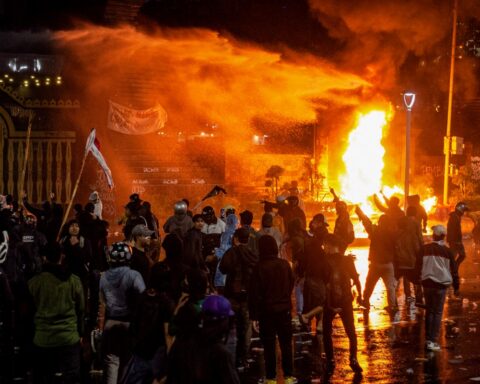“The history of all hitherto existing society is the history of class struggles.”[1]
Since the suppression and co-optation of the last global revolutionary attempt in the 60’s and the 70’s of the last century, the ideological dominance of the bourgeoisie is almost total in the most of the world: the level of the organized class activity is very low and its daily expression is limited to acts of individual subversion or at best localized sectional strikes and riots. In this text we want to put a spotlight on the events that shaking Iran last couple of weeks, events that go far beyond that, in the context of a region that consistently and for a long time stands on the forefront of the global class struggle, despite (and against) an enormous concentration of capitalist murderous capacity being unleashed there. We want to stress the class nature of these struggles and importance of the ruptures with the capitalist order that our comrades in Iran express!
While the big imperialist conflict, that the global and regional superpowers are waging for several years in Iraq and Syria[2] through their local proxies, is currently entering a state of temporary limbo, while the bourgeois factions and the armies and the militias serving their interests are licking their wounds, preparing and arming for the next round of carnage of the proletarian cannon fodder and their politicians and media are busy re-interpreting it as an image of victory, in order to sell it to “their citizens”, and reaffirm and fasten the leashes that bind our class to the democratic spectacle, the proletariat in the region is starting to raise its head again.
In December thousands of angry proles had taken to the streets all across the Iraqi Kurdistan and clashed with cops and Peshmerga units. In Sulaymaniyah province, protesters burned to the ground the Peshmerga headquarters as well as those of the main political parties (both of the government and the opposition side).[3] The parties’ offices were burned also in the town of Koye in Erbil province. The immediate reasons for their rage was a disastrous state of the basic services, like interrupted or inadequate supplies of clean water and electricity and several months of unpaid wages, especially in public sector. During the riots at least five of the protesters had been murdered by the repressive forces of the State and hundreds had been injured or arrested.[4]
On 28th of December, in Mashhad and Northern Iran, protests against the high cost of basic necessities and hungry riots had erupted, what will later turn into the biggest wave of class struggle in Iran since the movement of 2009.
Like any proletarian movement, this revolt didn’t just appear from nowhere, but it is an expression of months of anger and intensifying struggle against the living conditions in Capitalism.[5] Just like its Kurdish counterpart, the Iranian State’s involvement in the capitalist war in Iraq and Syria is starting to cripple its ability to appease the proletariat by throwing it breadcrumbs from the bourgeois table.
Spending on the Iranian military budget has been increasing over the last few years, with the army deployment, with the acquisition of modern Russian weapons to facilitate the massacre of the proletariat of the territories under the administration of the opposing factions of the global bourgeoisie (the role played by Daesh and the “Syrian opposition” for the moment), propping-up its allies of Assad’s regime, Hezbollah and Iraqi Shiite militias, as well as the investments in the oil, gas and other natural resources extraction and the transport infrastructure on the “liberated” territories (those projects are managed and realized by companies often directly owned by the Iranian Army or “Revolutionary Guards”).
This entanglement of the interests of the “Revolutionary Guards” represents a very explicit expression (it may appear more subtle or hidden in other cases, but it’s still there) of the fundamental role of the cycle of war and peace for the modus operandi of global Capital. On the one hand, both war itself and the subsequent scramble for reconstruction and investment in the peaceful period are nothing else than a concrete form of competition between capitalist factions. It is nothing else than the expression of the underlying need of the various factions of global Capital to expand their market in order to make for the decreasing rate of profit. At the same time, war serves a purpose to divide the class into categories along the national, regional, religious, political, etc. lines in order to suppress the class struggle and break the international solidarity of the proletariat. This is exactly what happened in Syria in 2011, when the local expression of the proletarian uprising against the misery of live in capitalist society and the State terror that swept the countries of Maghreb and Mashreq and beyond (labelled as “Arab Spring” by the bourgeois media in order to disguise its class character and prevent the solidarity from the proletariat in “non-Arab countries”), had been co-opted and channelled into the bloody inter-bourgeois war, by concerted effort of Assad’s regime, bourgeois-military leadership imposed on the FSA militants[6] and various foreign sponsors. Ultimately war serves as a mean to physically dispose of the redundant labour force, which is very relevant for the capitalist faction of the region with a huge unemployment, and in the near future will become more and more relevant globally.
Along with the continuing international sanctions, the war related costs convinced the bourgeoisie in Iran and administrators of its State, that it is the time to once again push for cuts to the aforementioned breadcrumbs in the form of benefits for 12 % of the workers who are officially unemployed (and as everywhere in this part of the world, much more, about 40 %, of the young workers), pensions and oil subsidies.
A massive wave of demonstrations and riots accompanied by collective expropriation of property had later spread to the cities all around the country, including the capital Tehran, where a pro-government rally coincided with the riots at the university and on the slum periphery.
As the protests spread more and more to include Tabriz, Qom, Isfahan, Rasht, Ahvaz, Sari, Zahedan, Qazvin as well as many smaller provincial cities and towns, their confrontational nature and the practical critique of property, commodity, misery of life in the capitalist society becomes more prominent. The administrative buildings of many public institutions, including the offices of the mullahs, police stations and Basij militia headquarters were burned to the ground. Looting of shops is widespread. In some cases, like in Kadharidzhan, groups of militant proles attacked the police station with the goal to loot the weapon cache and arm themselves for the continuation of the struggle! And indeed, on several occasions (in Nadzafabad in Central Provinces), the cops, the “Revolutionary Guards” and Basij militia members, besides being pelted with stones and Molotov cocktails like everywhere, were also been shot at with guns.[7] Other favourite targets are the banks (both those owned by the military-industrial conglomerate of the “Revolutionary Guards” and those owned by their multinational mothers). South Pars Oil and Gas workers went on strike over unpaid wages, as did workers in Tabriz tractor factory, bus drivers in Tehran, teachers, factory drivers and farm workers.
Protesters grasp the relation between the involvement of the Iranian State in the war in Iraq and Syria and its imperialist meddling in the politics of Mashriqi countries on the one hand and the current deepening of their misery on the other hand. They express it in their slogans – although in the majority in a contradictory and limited way, poisoned by nationalist and patriotic ideology – like “Neither Gaza, nor Lebanon, I will die only for Iran!”. This partial critique of war expresses the demand of the majority of this movement for the money flowing into the war industry to be redirected to social services, job creation for the youth, food and oil subsidies. Limitation of these demands is that they follow and consolidate the false dichotomy between the satisfaction of the “immediate” human needs of the proletariat, of the means of physical survival (food, shelter, etc.) and its “historical” need to destroy the class system. Only the existence of the unified humanity, through the centralized revolutionary action of the global proletariat, will be really able to satisfy our “immediate” needs as well as our “historical” needs which form an indissociable whole. These programmatical weaknesses are then being exploited by Social Democracy in the form of several Islamic factions, who pose themselves as protectors of the nation against the “western influence” as well as calling for the principles of the “Islamic social solidarity”, which means a refusal of capitalist war in favour of capitalist peace and national protectionism. The most advanced sectors of the proletariat oppose this with the firmly revolutionary defeatist motto “From Gaza to Iran, down with the exploiters!”
One of these radical minorities are definitely the revolting students in Tehran University, formulating also fundamental class positions against the attempts of the bourgeoisie and the various iterations of the historical Social Democracy (“Islamist” or “secular”) to divide the struggling proletariat along the gender lines, as well as along the lines of bourgeois political currents of “moderate” or “fundamentalist” politicians; and for the class associations outside and against the Social Democratic structures in the form of Shoras (worker’s councils).[8] Our class enemy has very well understood the leading programatical role that these comrades play in the movement and the State repressive forces are targeting them with an extraordinary ferocity.
Of course, not only Iranian religious hierarchy, various other local and global bourgeois factions do what they always do in the face of the proletarian class struggle, they unite in their efforts to divide and co-opt the movement and channel its energy away from its subversive class roots, attacking the material base of the capitalist society, to yet another democratic theatre with slightly reconfigured scenery. Thus Rouhani’s government, while claiming support for the “democratic right of the citizens to protest” denounced the violence against the State repressive forces and especially the attack against the private and State property and the expropriation of commodities, while Khamenei and “Revolutionary Guards” leadership is playing the nationalist chord, blaming the movement on work of “the foreign agents and the enemies of the republic”. Trump and Netanyahu, pretending to care about the lives of the “ordinary Iranian people”, called the regime a dictatorship, while Putin and Erdoğan, in the spirit of national self-determination, stressed the undeniable right of each and every bourgeois national State to discipline its “own” proletariat and suppress its struggle.[9]
This is in fact a fundamental and indivisible characteristic of the class struggle waged by the ruling class – the bourgeoisie – against our class. Enforcing and reproducing the false separations in our class along the lines of the factions of bourgeois interests expressed politically by myriads of categories (nation, race, gender, sexuality, religion, local patriotism, economic sector, political party, etc.)[10]is its central and only feasible strategy as unified global proletariat, that tends towards organizing itself in an autonomous and centralized way for its own class interests, is its mortal enemy and the harbinger of doom for the whole capitalist system.
While it seems that the social explosion, that we’ve seen in past several weeks in Iran is over, brutally repressed by the forces of the capitalist order, dulled by the selective promises of new social benefits and diluted in masses of loyal citizens mobilized by the State, the underlying material conditions that had caused it haven’t disappeared, and the ground in Iran is still very hot and fertile.
We want to stress and embrace again the most advanced moments of this wave of class struggle, despite being expressed only by a small minority of militants:
« Uncompromising revolutionary defeatist positions, clearly anti-posing the needs of the national factions of Capital to fight each other in the inherent cycle of competition for the market to realize the exchange value of their commodities, for the natural resources and for the imposition of its particular economic and political model of exploitation, as well as the needs of global Capital to keep our class divided in order to counter our proletarian interests to fight against our exploitation and miserable living conditions.
« Affirmation of the necessity to prepare and organize the violent uprising against Capital and its State including obtaining weapons, attacking key points of the State infrastructure, demoralizing the forces of repression.
«Attack on bourgeois morality that keeps our class atomized as obedient workers, church or mosque goers, wives and husbands, soldiers, voters.
All these tasks play an important role in the process of our class organizing itself as a global force that will destroy and overcome the last class society based on the exploitation of human labour and the exchange of commodities, in and through the global communist revolution. Therefore it is a duty for all communist militants to organize these tasks in the place where they live in, as well as globally, and to attack all the bourgeois falsifications that stand in the way of direct solidarity with our class brothers and sisters in other parts of the world. As the proletariat in the part of the world that the bourgeois media and geopolitical strategists call “the Middle East”, “the Muslim World”, “the Arab Countries”, etc. continues to represent one of the most intensive poles of the global class struggle, with almost daily wildcat strikes, riots, looting and myriads of attempts of class organizing outside and against Social Democracy, it is crucial for the global communist movement to stress the real character of these struggles against all the prejudice internalized by the proletariat in the rest of the world as well as against all the attempts of the local Social Democracy (Islamist, Islamic left, Leninist, “Libertarian Municipalist”, Nationalist, Liberal, etc.) to exploit the contradictions in those struggles, to co-opt and channel them into democratic, reformist, pro-capitalist movement.
We expect this text to be a contribution to assume and take on these tasks.
« The capitalistic economy is in crisis, may it die!
« The enemy is capitalism and the dictatorship of world market!
« The objective is everywhere the same: social revolution!
« Destruction of capitalism and the State!
« Class War – winter 2017/18 «
[1]“[…] labor is external to the worker, i.e., it does not belong to his intrinsic nature; that in his work, therefore, he does not affirm himself but denies himself, does not feel content but unhappy, does not develop freely his physical and mental energy but mortifies his body and ruins his mind. The worker therefore only feels himself outside his work, and in his work feels outside himself. He feels at home when he is not working, and when he is working he does not feel at home. His labor is therefore not voluntary, but coerced; it is forced labor. It is therefore not the satisfaction of a need; it is merely a means to satisfy needs external to it.” (Karl Marx, Economic and Philosophical Manuscripts of 1844)
“Instead of the conservative motto: ‘A fair day’s wage for a fair day’s work!’ they ought to inscribe on their banner the revolutionary watchword: ‘Abolition of the wages system!’” (Karl Marx, Value, Price and Profit, 1865)
[2] Or rather should we say the regional expression of its openly militaristic face, with others, less intensive for the moment, “theatres” being Ukraine, Yemen and soon possibly South China Sea.
[3]Government parties Kurdistan Democratic Party (KDP) and Patriotic Union of Kurdistan (PUK) as well as opposition parties Gorran and Kurdistan Islamic Union.
[4] Similar causes fuel also the class struggle in Tunisia, where months of street protests and worker’s strikes against the lack of jobs, rising prices of food, gasoline and cuts in social benefits are culminating into yet another wave of widespread riots – the “proletarian celebration” of the 2011 uprising anniversary – biggest since May of 2017 (when police stations and oil and gas pumping stations of ENI, OMV and Perenco burned like candles). The protests scared the ruling class into quickly backpedalling and announcing new form of the social benefits and State guaranteed mortgages, while simultaneously cracking down on the protesters and arresting hundreds.
[5] “This has resulted in a year of diffuse but contiguous rallies, demonstrations, and sit-ins: The students opposing the privatization and commodification of education; the retired opposing the bankrupt retirement accounts; Teachers and nurses protesting against inhuman living conditions, the bus drivers supporting their syndicate members; and innumerable strikes in various sectors, from miners to sugarcane workers.”http://libcom.org/news/iran-bread-jobs-freedom-05012018
[6] As a distant echo to the process of militarization of the “Red Guards” during the Revolution in Russia in 1917 or of the “workers militias” in Spain in 1936 (for taking only two known and revealing historical examples), the different “liwas” (brigades) and “katibas” (battalions) that emerged in the revolutionary dynamics in Syria as from 2011 expressed and materialized at a given moment the contradictions of the current social movement. Created by and initially constituted of “deserter soldiers” and “civil proletarians” to protect the movement from the terror exerted by government repressive forces, these grassroots organizations and other armed militias (not very clear as for their political and social program, just as the “Red Guards” and “workers’ militias” were not clear in their time) will be framed by political forces of the bourgeois opposition while therefore being known under the generic name of the “Free Syrian Army”, and will rapidly and inevitably transform themselves into armies serving different factions of the bourgeoisie through their own weaknesses and lack of rupture on one hand, and through deceit, violence and nationalist and Islamist propaganda on the other hand.
[7] Unfortunately, we have to say that the capitalist forces of repression are having the upper hand and they are doing all things possible to once again drown the class movement in blood. At least one hundred (by the time of writing) of our class brothers and sisters had been massacred by them with thousands seriously injured or arrested. We would like to appeal to our comrades all around the world and in the region neighbouring Iran in particular, to express the class solidarity with these militants also practically, to shelter and hide them from the State terror, to help them to re-group, to demand their release from prison, to directly attack the representatives of Iranian faction of the global bourgeoisie and its interests (along with their “own” bourgeoisie of course).
[8] Let’s remind that neither workers’ councils nor soviets or any other form of proletarian organization is in itself a guarantee of the content of the revolution.
[9] Other Social Democratic false friends of the class vomited their statements of “support” of the movement including Daesh, PYD/PKK (and their militias) and of course MEK. All of them have been showing for many years that they are experts in extinguishing by embracing any spark of class anger they can lay their hands on and turning the struggling proletarians into their supporters and cannon-fodder in the inter-bourgeois bloodshed.
[10] We salute all our class brothers and sisters in Iran, who spitted in the face of Mullahs and their cops, flavoured by the deadly fairy tales of Islam, version of the capitalist morality, with rules like separation of sexes in public or stupid dress codes forcing the women to wear some kind of rag on their head. But even more, we salute those of the proletarian women, who in the act of the practical detournement turned those rags into weapon against the State, as makeshift balaclavas, slingshots, etc.
______________________________________________________________________
more info and analysis: Class War
